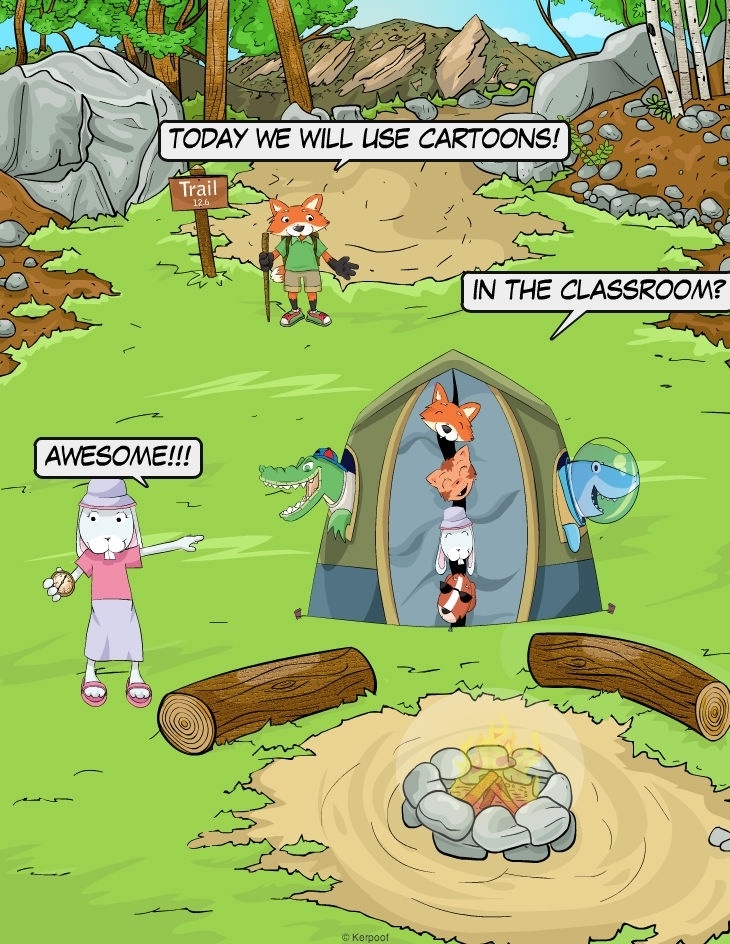Enhancing Your Teaching With Comic Strip Making Websites
I have always believed that learning should be fun. That was my own experience since childhood.
When I was a kid, I began learning how to read while looking at the beautifully drawn cartoon characters in the Sunday funny pages. I was challenged to decipher the white balloons coming from the characters mouths or above their heads. I knew instinctively that if I could begin to understand what the black printed letters in the balloons meant, I could better understand what the amazing stories were about. And with help from my parents, I began sounding out the letters which made words. In a short time I became a good reader.
I never forgot the pleasure of reading comic strips and joke books and when I grew up I began working with cartoonists and illustrators to create art for the newspaper I edited and for the books I began to write. I knew that comic illustrations would provide a way to draw in people to read and saw in the computer the power to generate comics. A few years ago, I launched a website –http://www.makebeliefscomix.com– to empower teachers, trainers, and students to create their own comic strips online. Since then more digital comic strip generators have become available.
Comics To Build English Language Skills
As a teacher in ESOL and literacy programs, I understood that enabling struggling students to write and tell stories by building comic strips online would be a way of strengthening their emerging English language skills and make the difficult job of learning English a much more enjoyable experience. If students are having fun they can accomplish anything they want in learning.
The MakeBeliefsComix.com site works this way: Users can select from more than 200 fun characters with different moods; happy, sad, angry, worried. The characters are a combination of human and animal characters with human characteristics. The characters are meant to be diverse and inclusive and are of various skin colors and types, including one who is in a wheelchair. All are friendly and engaging so that users will want to play with them and create words for them in the blank talk and thought balloons to make their characters talk and think. There also are story ideas and prompts provided to help users create graphic stories.
This site can be used by educators to teach language, reading, and writing skills, and also for students in English-as-a-second-language programs to facilitate self-expression and storytelling. A teacher, for example, could use the strip to practice dialogue spoken by characters. And with computer literacy so emphasized today in ESOL and literacy programs, the very act of encouraging a student to create a simple comic strip online also provides a way for students to become more comfortable in using the computer. As they learn to negotiate the site and move characters and thought balloons around, they are also improving their computer skills.
Helping People Who Are Autistic
Some educational therapists also use the site with people who are deaf or autistic and trauma victims to help them understand concepts and communicate. Teachers can create scripts to help people practice certain situations, such as greeting someone, or interviewing for a job, or talking with a teacher about their children’s problems. Some teachers use the strips as storyboards to help students more easily understand books that their students may be reading in class. One teacher in Australia told me, for instance, that she created story boards with the site to help her students better understand Shakespeare’s Romeo and Juliet. Students reading a book might use MakeBeliefsComix to extend the story by writing about a character whose life and adventures continue after the book is closed, or even to write a different ending. Better yet, they can use the online comix-maker to write their own story.
Educators who are teaching new vocabulary might have students create a comic strip in which the characters use the new words that have been learned that day in class. Having to write sentences for characters to speak also provides a way to practice sentence structure and learn grammar. Students who have been assigned a book to read might create a comic strip or strip series summarizing the book’s ideas.
In making comic strips, we also have an easy, fun way to engage in make-believe conversations that allow students to practice speaking, to work individually or collaboratively, as well as to practice creative writing.
A teacher also could put together a comic strip with characters and blank thought or talk balloons, print it out, and ask students to fill in the balloons with words and narration. Better yet, a student can choose his or her own characters and develop stories alone or with a partner. One teacher I know who was teaching prepositional phrases had her students use online comics to include sentences with such phrases. Having to write sentences for characters to speak provides an engaging way to practice sentence structure and learn grammar.
After a student completes her comic strip, she is encouraged to publish or print out copies to keep of her work. This validates her creative writing effort. The site also allows her to email a copy to a friend or relative. The students love seeing the finished comic strips and can keep them in their portfolios to look at and enjoy their hard-earned effort to create something new. Students like showing their families and friends what they have created. The creation of the comics, thus, becomes an empowering experience for many students and reinforces the learning they have accomplished.
Creating Comics To Draw Families Closer
Parents and children in family literacy programs can also create stories together, print them to create comic books or email them to friends and family. Generating strips also becomes a tool to help parents and children work jointly and communicate effectively in creating something new. Others will find the site a resource to be creative, calm down and have fun – something that is needed as students struggle so mighty in class to master a new language.
I have been conducting workshops both for students who are learning English as a second language and with those who as struggling to be literate. Generally, in showing students how to use the site, I will create with them a group comic strip incorporating their ideas. This becomes a great class collaboration. We’ll choose a subject for example, such as going for a job interview, or making conversation with a friend, or going on a date, or deciding what we want to do this coming weekend or where we want to go on a vacation. Then we’ll create a story together, using one or two characters in each panel. The characters become surrogates for ourselves and can be used, too, to help students work out problems or situations that are troubling them in their lives, such as bullying.
I might then start a dialogue in one of the talk balloons, asking the students to choose a character and for suggestions for dialogue, and then I’ll ask for more dialogue for another character to speak. Then we’ll try to move the story along by moving to a second panel. Later, when students start their own comic strips, I encourage them to work with a partner to help each other along. Such collaboration gives students more confidence and ideas in creating a story, and in working together the students improve their language skills as they come up with words and ideas for the characters to say and execute.
I remember working with a group of Chinese and Hispanic students who were first learning English. For almost three hours at one session they worked collaboratively at the computer site for almost three hours until they had fully shaped and completed their comic story. Each student helped the other put the words together into sentences for the dialogue balloons. Just the experience of having to talk together and create make-believe dialogue for the characters enhances communication skills. There also are story prompts included on the site to give students ideas for themes, such as Travel to a Mysterious Place, A Day at School, Write a Love Story, Finding Your Courage, Making Wishes Come True, and A New Fairy Tale.
I have yet to see a frown or a tear shed in the language learning process of creating and working with digital comics.








